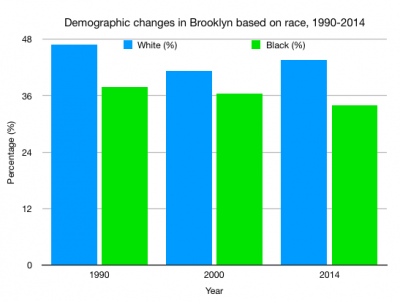Brooklyn is one of the five boroughs located in New York City and it is recognized as a global city, a green city, and a gentrifying city. It is a global city because there are 2.5 million residents and one-third of its residents were born outside of the U.S. Brooklyn has becoming self-consciously “green” in the twenty first century with a number of recent high-profile LEED certified buildings, new bike routes, and ambitious greenways are highlighted, as well as the high ratings local elected officials receive from environmental advocacy groups. Kenneth A. Gould and Tammy L. Lewis, authors of “Green Gentrification: Urban Sustainability and the Struggle for Environmental Justice”, argue that this increased “greening” occurring in Brooklyn is leading to a jump in the city’s gentrification rate. Much of the city’s growth is due to internal migration meaning Americans are flocking to Brooklyn and foreign immigrants are being forced out of the city they’ve lived in for decades. “Green gentrification” is defined as the appropriation of the economic values of an environmental resource by one class from another (Gould & Lewis, 25). This means that as environmental resources in Brooklyn become more available as amenities, that area of Brooklyn becomes more attractive to the wealthy, white in-migrants of the U.S.
I took data provided in Gould & Lewis’s book that was focused on Brooklyn as a whole, as opposed to a single neighborhood, and graphed the increase of the white population compared to the decrease of the black population from 1990 to 2014.
As the graph shows, the green bar represents the black percentage in Brooklyn which has been gradually decreasing as the blue bar, which represents the white percentage in Brooklyn, has stayed steadily higher from 1990 to 2014. Gould and Lewis argue that this is a result of green gentrification and environmental injustice in Brooklyn because wealthier, white residents are attracted to the quality of environmental amenities and push out low-income, black residents in the process.



The gentrification process in Brooklyn is extremely interesting, and is something I looked at in this week’s blog myself. However, I did not look at the ways residents in Brooklyn become eco-friendly. I thought this was a really interesting aspect of gentrification, and something I have rarely thought about. I already understood the idea that gentrification pushes out low-income families, however, I never realized that when the more affluent families move in, it could positively address sustainability issues. And this makes sense—most of the time, eco-friendly processes are more expensive, and therefore are not always a resource for everyone. The idea of green gentrification seems extremely likely as an outcome of gentrification as a whole.
I found your post really interesting in that the gentrification of Brooklyn is something that is not often viewed through a sustainability and eco-friendly lens. More often, Brooklyn’s gentrification is attributed to other causes, like lower cost of living. I think it is important, too, to note as Makenzie mentions that as more affluent families move in, they are more likely to positively address sustainability issues. Perhaps gentrification is, in that sense, not such a horrendous development.
I think you bring up a very important point here. In high school I was in a class in which we discussed at great length the benefits and the downfalls of gentrification. We went into different parts of manhattan and interviewed residents on their point of views, and opinions were mixed. While long time residents were less excited about the changes, the newer residents were very excited about the changing neighborhoods.